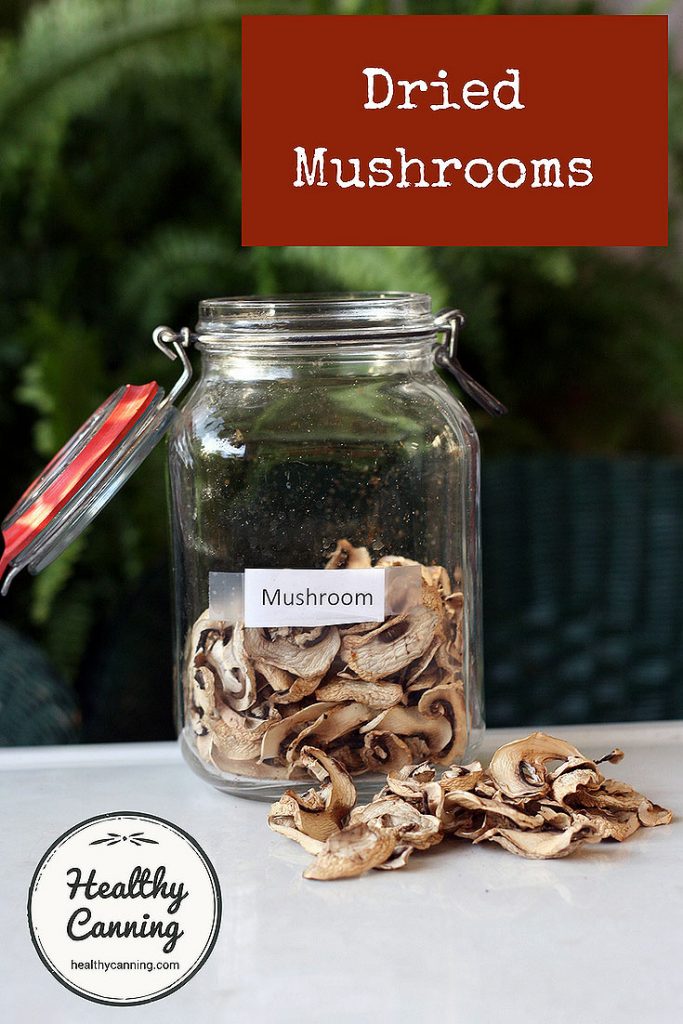Dehydrated mushrooms can have a wonderful concentration of flavour that adds a depth of background taste to many dishes.
They are amongst the easiest vegetables to dry.
You can use them in cooked dishes the same as you would use cooked mushrooms.
You may also pressure-can plain mushrooms, or marinate and pickle them using a tested recipe. They may also be frozen, raw or cooked.
See also: Mushroom powder
Yields and Equivalents
7 lbs (3 kg) fresh mushrooms = 1 lb (500 g) dried [1]Hill, Deborah B. Kentucky Shiitake: Processing and Storage. University of Kentucky Cooperative Extension Service. FOR-86. March 2013. Page 2.
Directions
Dry only fresh mushrooms in good condition. Mushrooms that are well past their prime won’t make a good dried product.
Here we compare drying directions from three different sources.
Ball Blue Book
Preparation: “Wash quickly to remove dirt, cut into ¼ inch slices.”
Blanching: None
Temperature: 125 F / 52 C
Time: Until brittle
Notes: “Choose only edible, cultivated mushrooms with small, closed caps.”
Water content: 90%. (Used if doing a Dehydration Weight Test.)
Reference: Ball Blue Book, 37th edition, 2014. Page 166.
Note: in the Ball All New (2016, page 339), Ball calls for the stems to be removed, and 4 to 6 minutes of steam blanching.
Excalibur
Preparation: “Brush off any dirt and wipe with a damp cloth or quickly wash mushrooms in cold water; never soak. Remove the woody portion of the stem and cut into ⅜″ (1 cm) slices from the cap through the stem.”
Blanching: Pretreatment not necessary, however, you can steam blanch 2 to 3 minutes over water. You may use 1 teaspoon sodium bisulfite per cup water.”
Temperature: 125 F / 52 C
Time: 3 to 7 hours until leathery.
Quality: Good
Reference: Excalibur. Preserve it naturally. 4th edition, 2012. Pages 26 and 57.
So Easy To Preserve
Preparation: “Scrub thoroughly. Discard any tough, woody stalks. Cut tender stalks into short sections. Do not peel small mushrooms. Peel large mushrooms. Slice.”
Blanching: None
Drying temperature: 140 F / 60 C
Drying time: 8 to 10 hours
Quality: Good
Reference: So Easy To Preserve. 6th Edition. 2014. Page 350.
Notes
With regard to washing mushrooms first, don’t worry about them absorbing water: that’s a myth.
So Easy to Preserve gives this caution about poisonous mushrooms: “The toxins of poisonous varieties of mushrooms are not destroyed by drying or cooking. Only an expert can differentiate between poisonous and edible varieties.” [2]So Easy To Preserve. 6th Edition. 2014. Page 351.
Allergy sufferers may be interested in this caution from the University of Alaska:
Choose a well-ventilated area …. Be aware that some people may have allergic reactions from drying mushrooms in their home. If you have allergies or have never dried mushrooms before, do not try to dry mushrooms inside your home.” [3]Dinstel, Roxie Rogers, Ed. Collecting, Preserving & Using Morel Mushrooms. University of Alaska Fairbanks Cooperative Extension Service. 2017. FNH-00020. Page 2.
Ed: We haven’t been able to find out exactly what the allergy concern would relate to; it may possibly be spores. “Worker exposure to airborne spores is a concern on most farms. Inhaled spores can cause an allergic reaction in some workers.” [4]Beyer, David Meigs. “Cultivation of Oyster Mushrooms. Penn State Extension. 14 August 2017. Accessed December 2017 at https://extension.psu.edu/cultivation-of-oyster-mushrooms
Usage notes
The University of Alaska says,
Pour boiling water over dried mushrooms and simmer 20-30 minutes or until they have returned to their original shape. Use a ratio of one part mushrooms to three parts water. Use as specified.
OR, Add dried mushrooms to a product with lots of liquid, such as soup. Cook for at least 20 minutes. This will rehydrate the mushrooms and cook them in a single step.” [5]Dinstel, Roxie Rogers, Ed. Collecting, Preserving & Using Morel Mushrooms. University of Alaska Fairbanks Cooperative Extension Service. 2017. FNH-00020. Page 2.
Storage
Let the dehydrated product cool completely to room temperature before packing it into storage containers.
Watch the sealed containers for the first few days for any sign of condensation. If condensation occurs, dehydrate a bit more.
Label jar with name of product and date. Store away from heat and direct light.
References


Elizabeth
Hello: I am trying to find an answer to this: I have read quite a bit about how we do not digest uncooked mushrooms due to the fibrous cells and that mushrooms just pass through without humans getting the nutrients so it is important to always cook them first. So with that in mind, the next thing I learned is that dehydrating is not hot enough to break down this fibrousness to digest either. So I wondered if cooking mushrooms first before dehydrating would be the best way to go about getting the most nutrition from the mushrooms. If so, I wonder how long to cook them? I would think that boiling would be best, not merely a blanche of a couple of minutes. Does anyone here have any ideas about this? I would really like to get the most food value, especially from shitakes.
Anon
I know this is kinda old, well really old at this point, but if you have any doubts about getting the full value of these mushrooms, grind it up into a powder with things like Salt, Paprika or whatever spices and herbs that suit your own personal tastes. The mushroom powder you get out of it blooms really well in almost anything you cook using it and provides you with a nice depth of flavor.